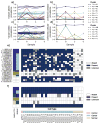PyClone: statistical inference of clonal population structure in cancer
- PMID: 24633410
- PMCID: PMC4864026
- DOI: 10.1038/nmeth.2883
PyClone: statistical inference of clonal population structure in cancer
Abstract
We introduce PyClone, a statistical model for inference of clonal population structures in cancers. PyClone is a Bayesian clustering method for grouping sets of deeply sequenced somatic mutations into putative clonal clusters while estimating their cellular prevalences and accounting for allelic imbalances introduced by segmental copy-number changes and normal-cell contamination. Single-cell sequencing validation demonstrates PyClone's accuracy.
Figures


References
Publication types
MeSH terms
Grants and funding
LinkOut - more resources
Full Text Sources
Other Literature Sources
Molecular Biology Databases

